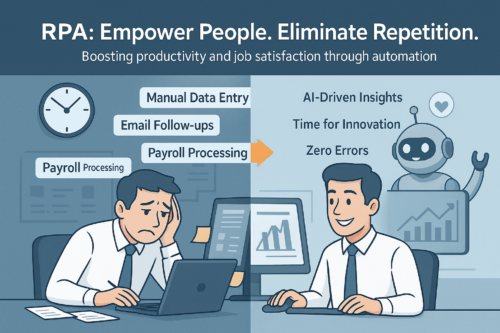
Introduction: Redefining Work in the Digital Age
In today’s fast-paced, technology-driven world, businesses are under increasing pressure to improve efficiency, reduce costs, and deliver faster outcomes. But amid this push for performance, many organizations overlook a critical factor—the experience of the people doing the work.
For countless professionals, a significant portion of the workday is consumed by repetitive, manual tasks—copy-pasting data, processing forms, generating reports, updating records. These activities not only slow down productivity but also contribute to employee fatigue and disengagement.
Enter Robotic Process Automation (RPA)—a transformative technology that does more than just streamline operations. When implemented effectively, RPA becomes a catalyst for workplace empowerment, allowing employees to shift their focus from mundane execution to impactful, value-driven work.
What Is Robotic Process Automation (RPA)?
Robotic Process Automation (RPA) is the use of software bots to automate rule-based, repetitive tasks typically performed by humans on digital systems. These bots interact with software applications in the same way a person would—clicking, typing, copying, and pasting—but they do it faster, without errors, and around the clock.
Whether it’s processing invoices, reconciling accounts, managing onboarding workflows, or extracting data from emails, RPA offers a seamless way to improve accuracy, reduce turnaround time, and enable businesses to scale operations without increasing overhead.
Enhancing Employee Productivity Through RPA:
Implementing RPA in business operations has a direct and measurable impact on productivity. Here’s how it works:
1. Reduces Time Spent on Low-Value Tasks
Employees often spend 30–40% of their time on repetitive administrative duties. By deploying RPA bots to handle these tasks, teams can redirect their energy toward higher-priority, value-added work such as strategic planning, client interaction, and problem-solving.
2. Minimizes Operational Errors:
Manual tasks are susceptible to human error, especially when performed under pressure or fatigue. RPA ensures consistent execution by following set rules and logic, resulting in improved data accuracy, compliance, and process reliability.
3. Enables Faster Process Completion:
Unlike human workers, RPA bots can operate 24/7, across multiple systems and without delays. This means quicker task turnaround, faster approvals, and less waiting for dependent teams.
4. Supports Scalable Growth Without Proportional Headcount:
As businesses grow, so does the workload. With RPA, organizations can scale operations without increasing staff size, allowing human workers to manage exceptions and oversee strategic initiatives while bots handle transactional volume.
5. Facilitates Better Use of Human Talent:
When employees are freed from repetitive activities, they can focus on the work they were hired to do—work that requires critical thinking, creativity, and emotional intelligence. This not only improves output but also enhances the organization’s competitive edge.
Boosting Job Satisfaction with RPA:
RPA doesn’t just improve efficiency—it transforms how employees experience their roles. Here’s how RPA fosters a healthier, more engaging workplace:
1. Increases Engagement and Motivation:
When employees spend less time on tedious work, they have more opportunities to contribute meaningfully. This shift leads to greater engagement, ownership, and job satisfaction.
2. Reduces Burnout and Mental Fatigue:
Repetitive digital tasks can be mentally exhausting. By automating such work, RPA reduces cognitive load, helping employees feel more energized and focused.
3. Creates Space for Professional Growth:
With RPA managing the routine, employees can engage in learning new skills—such as bot management, process optimization, or data analysis. Organizations can also invest in upskilling teams to work alongside automation, turning workers into process designers and automation champions.
4. Supports Hybrid and Remote Work Environments:
RPA enables self-service portals and automated backend processes, reducing dependencies and support requests. This is especially beneficial for remote teams, who can work more independently and productively.
Real-World Example: RPA in HR and Recruitment:
Let’s consider a typical HR department in a mid-sized company.
Before RPA:
HR professionals spend hours manually screening resumes, coordinating interview schedules, drafting offer letters, and processing new hire documentation.
With RPA:
- Bots scan resumes for job-fit criteria and shortlist candidates.
- Interview slots are automatically booked based on calendar availability.
- Onboarding documents and emails are generated without manual input.
Result:
The HR team can now focus on building relationships, enhancing employer branding, and improving employee experience—not just moving paperwork.
How to Successfully Adopt RPA
To maximize the value of RPA, organizations should take a structured approach:
1. Identify the Right Processes:
Start by targeting tasks that are repetitive, rules-based, and high in volume. Finance, HR, IT support, and operations are common starting points.
2. Select a Reliable RPA Partner:
Choose an experienced RPA implementation partner who understands your business landscape and can design scalable automation with security and compliance in mind.
3. Pilot, Then Scale:
Run a pilot to validate assumptions and measure ROI. Once successful, expand RPA to other departments and integrate it into broader digital transformation goals.
4. Invest in Change Management:
Communicate transparently with employees. Involve them in process mapping, train them on working alongside bots, and reposition RPA as a tool for supporting—not replacing—them.
Why Partnering with an RPA Expert Matters:
Implementing RPA is not just about choosing the right technology—it’s about deploying it in a way that aligns with your business goals and people strategy.
An experienced RPA automation partner will:
- Conduct detailed process assessments.
- Customize bots to fit your systems.
- Ensure regulatory compliance.
- Provide ongoing maintenance and bot training.
- Help you scale automation across functions.
By working with the right experts, you ensure your RPA strategy enhances productivity while preserving employee well-being.
Conclusion: RPA is the Future of Human-Centered Work:
In an era where efficiency is non-negotiable, Robotic Process Automation offers a solution that benefits both the business and the people who power it. Far from eliminating jobs, RPA gives employees a chance to thrive—by eliminating the friction of repetitive work and opening the door to creativity, innovation, and growth.
Organizations that embrace RPA with empathy, planning, and vision are not just preparing for the future—they’re building a more empowered, resilient, and productive workforce today.
Ready to explore the intelligent future of RPA?
Talk to 4devnet—your trusted RPA development company and AI-enabled transformation partner.
